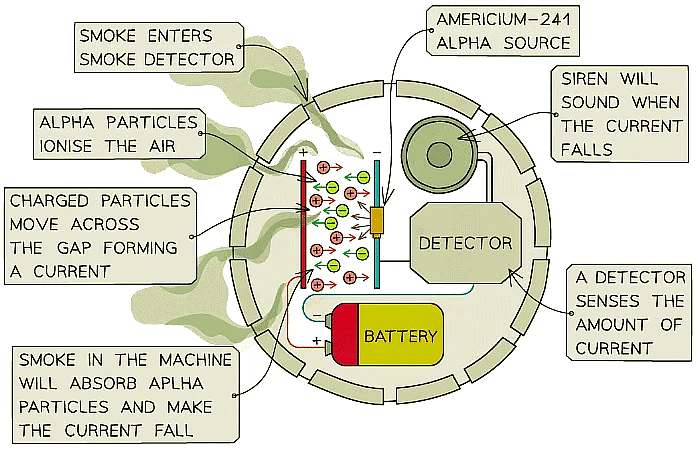Grade 10 Exam > Grade 10 Notes > Physics for Grade 10 > Types & Uses of Radiations
Types & Uses of Radiations | Physics for Grade 10 PDF Download
Types of Radiation
- When an unstable nucleus decays it emits radiation, called nuclear radiation
- There are different types of radiation that can be emitted:
- Alpha
- Beta
- Gamma
- Neutrons
Alpha Particles
- The symbol for alpha is α
- An alpha particle is the same as a helium nucleus
- This is because they consist of two neutrons and two protons
- Alpha particles have a charge of +2
- This means they can be affected by an electric field
Beta Particles
- The symbol for beta is β
- Beta particles are fast-moving electrons
- They are produced in nuclei when a neutron changes into a proton and an electron
- Beta particles have a charge of -1
- This means they can be affected by an electric field
Gamma Rays
- The symbol for gamma is γ
- Gamma rays are electromagnetic waves
- They have the highest energy of the different types of electromagnetic waves
- Gamma rays have no charge
Neutrons
- The symbol for a neutron is n
- Neutrons are one of the two particles found in the nucleus of atoms
- Neutrons are neutral, they have no charge
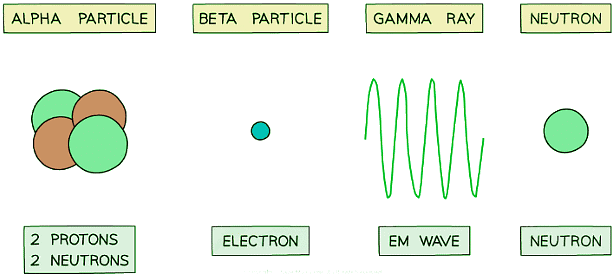 Alpha particles, beta particles, gamma waves and neutrons can be emitted from unstable nuclei
Alpha particles, beta particles, gamma waves and neutrons can be emitted from unstable nuclei
Properties of Alpha, Beta and Gamma Radiation
- The properties of Alpha, Beta and Gamma are given in this table, and then described in more detail below
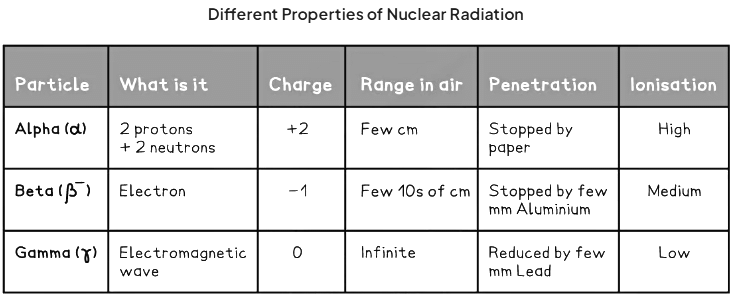
- The trend down the table shows:
- The range increases
- Penetrating power increases
- Ionisation decreases
Penetrating Power
- Alpha, beta and gamma have different properties
- They penetrate materials in different ways
- This means they are stopped by different materials
 Alpha, beta and gamma are different in how they penetrate materials. Alpha is the least penetrating, and gamma is the most penetrating
Alpha, beta and gamma are different in how they penetrate materials. Alpha is the least penetrating, and gamma is the most penetrating - Alpha is stopped by paper, whereas beta and gamma pass through it
- Beta is stopped by a few millimetres of aluminium
- Gamma can pass through aluminium
- Gamma rays are only partially stopped by thick lead
- This means they are stopped by different materials
Ionising Power
- All nuclear radiation is capable of ionising atoms that it hits
- When an atom is ionised, the number of electrons it has changes
- This gives it a non-zero charge
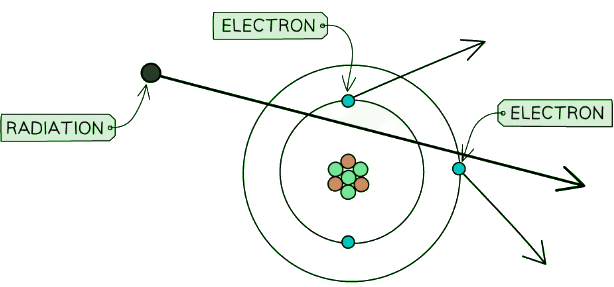 When radiation passes close to atoms it can knock out electrons, ionising the atom
When radiation passes close to atoms it can knock out electrons, ionising the atom - Alpha radiation is the most ionising form of nuclear radiation
- This is because alpha particles have a charge of +2
- Gamma radiation is the least ionising form of nuclear radiation
Range in Air
- The more ionising a form of radiation is, the sooner it will react with the air it is moving through
- Strongly ionising radiation has the shortest range in air
- Alpha only travels a few centimetres in air
- Beta has a range of a few tens of centimetres
- Gamma is not absorbed by air and so has an infinite range, although it does get less intense with distance
Question for Types & Uses of RadiationsTry yourself:A student has an unknown radioactive source. They are trying to work which type of radiation is being given off:
They measure the count-rate, using a Geiger-Muller tube, when the source is placed behind different material. Their results are shown in the table below:

Which type of radiation is being given off by the source?
View Solution
Tip: Make sure to memorise the different types of radiation, as these are common exam questions. However, neutron radiation is less common and it is not required to know its properties for the exam
Uses of Radiation
- Radiation is used in a number of different ways, for example:
- Producing electricity through nuclear fission
- Medical procedures including diagnosis and treatment
- Testing material
- Determining the age of ancient artefacts
- Checking the thickness of materials
- Smoke detectors
- The properties of the different types of radiation determine which one is used in a particular application
Smoke Detectors & Alpha Particles
- Alpha particles are used in smoke detectors
- The alpha radiation will normally ionise the air within the detector, creating a current
- The alpha emitter is blocked when smoke enters the detector
- The alarm is triggered by a microchip when the sensor no longer detects alpha

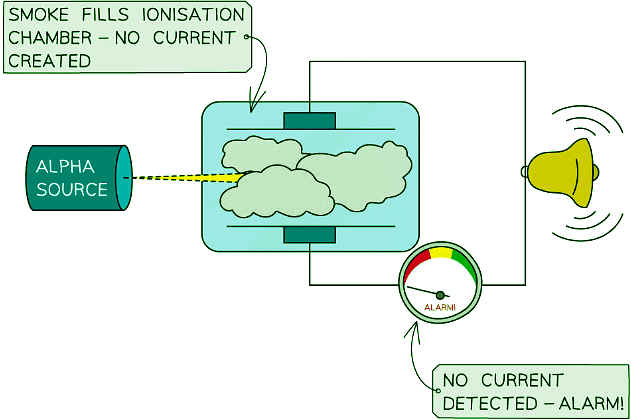 In the diagram on the right, alpha particles are stopped by the smoke, preventing the flow of current and triggering the alarm
In the diagram on the right, alpha particles are stopped by the smoke, preventing the flow of current and triggering the alarm
Tips
- You do not need to know the different uses of the different types of radiation but you must be able to use your knowledge of the properties of the different types in order to determine which source is the most appropriate for a particular use.
- If you are presented with an unfamiliar situation in your exam don’t panic! Just apply your understanding of alpha, beta and gamma radiation - the answer will be found among those three.
Example: Explain why is alpha radiation used in smoke detectors, and not beta or gamma radiation.
- Consider the different properties of alpha, beta and gamma:
(i) Alpha is the most weakly penetrating and strongest ioniser
(ii) Beta and gamma have stronger penetrating power and weaker ionising power- If beta or gamma radiation were used in this situation then they would pass straight through the smoke and the alarm would not go off
- Therefore, since alpha is absorbed by smoke, and beta and gamma are not, this makes it most suitable for use in a smoke detector
The document Types & Uses of Radiations | Physics for Grade 10 is a part of the Grade 10 Course Physics for Grade 10.
All you need of Grade 10 at this link: Grade 10
|
122 videos|150 docs|40 tests
|
Related Searches


